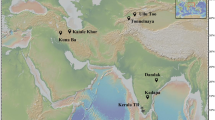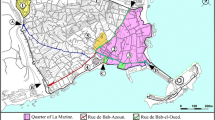Abstract
Certain aspects of the biblical story of the Cities of the Plain have in recent years become widely accepted. Among them is the placing of those cities in the southern basin of the Dead Sea, the assumption that those cities are now covered by Dead Sea water and, in particular, the belief that their destruction was due to catastrophic geological causes, such as an earthquake. The Bible emphasizes the agricultural richness of the Jordan plain prior to the upheaval of Sodom and Gomorrah and its catastrophic transformation into a wasteland. Thus, stripped of ethical and religious overtones, the scenario is that of a rapid climatic change that converted a densely inhabited and richly watered area into an infertile salt playa. The region northeast and southeast of Jericho, which today is quite barren as a result of the upward movement of salty ground water but which contains some of the World's earliest known agricultural settlements, fits such a picture. Dating the Sodom event to approximately the 23rd-21st centuries B.C. supports the idea that a major climatic change that occurred between the Early and Middle Bronze Ages and which resulted in profound transformations in the Middle East such as the collapse of the Ancient Kingdom of Egypt, the invasion of the Fertile Crescent by the Semitic desert nomads, and the collapse of Early Bronze Age civilization in Palestine - is also responsible for the Sodom story. Although the data are far from complete, desiccation during this period is indicated by palynological evidence pointing to the decimation of forests in Northern Israel, paleobotanical evidence from Southern Israel, the deposition of salt layers in the Dead Sea, the abandonment of almost all settlements in the Negev Desert of Southern Israel, the Jordan valley and Southern Jordan, except those which were associated with perennial springs, and further afield the drastic lowering of the level of Lake Moeris in Lower Egypt. This scenario does not exclude the possibility that a major earthquake - which may have occurred during this period - was considered to be the cause of the final physical destruction of the Cities of the Plain, delivering a coup de grace to a collapsing society, and which became through the mists of time and legend, the only agent of destruction.
Similar content being viewed by others
References
Almogi-Labin, A., Hembelden, C., Meischner, D., and Erlankeuser, H.: 1991, ‘Paleoenvironmental Events during the Last 13,000 Years in the Central Red Sea as Recorded by Pteropoda’,Paleoceanography 6, 83–98.
Amiran, D. H. K.: 1991, ‘The Climate of the Ancient Near East, The Early Third Millennium B.C. in the Northern Negev of Israel’,Erdkunde 45 (3, 153–162.
Amiran, R. and Kokhavi, M.: 1975, ‘Canaan at the Close of the Third Millennium BCE - an Independent Culture or the Final Phase of the Early Bronze Age?’, inEretz Israel, v.18 (Avigad Volume), Israel Society for the Study of Israel and its Antiquities, Jerusalem, pp. 361–365.
Avner, U.: 1990, ‘Ancient Agricultural Settlements and Religion in the Uvda Valley in Southern Israel’,Biblic. Archeol. 53, 125–141.
Baney, R. E.: 1962,Search for Sodom and Gomorrah, C. A. M. Press, Kansas City.
Bell, B.: 1971, ‘The Dark Ages in Ancient History, I. The First Dark Age in Egypt’,Amer. J. Archael. 75, 1–26.
Ben-Menahem, A.: 1979, ‘Earthquake Catalogue for the Middle East (92 B.C. - 1980 A.D.)’,Boll. Geof. Teor. App. 21, 245–310.
Ben-Tor, A.: 1989, ‘The Early Bronze Age’, inThe Archeology of Ancient Israel in the Biblical Period (unit 4), The Open University, Tel Aviv, 11–74 (in Hebrew).
Bentor, Y. K.: 1990, ‘Geological Events in the Bible’,Terra Nova 1, 326–338.
Block, J. W.: 1975, ‘“Sodom and Gemorrah”: A Volcanic Disaster’,J. Geol. Edu. 23 (3, 74–77.
Crown, A. D.: 1972, ‘Towards a Reconstruction of the Climate of Palestine 8000 B.C.-0 B.C.’,J. Near Eastern Studies 31, 312–330.
Fargo, V. M.: 1979, ‘Settlement in Southern Palestine during Early Bronze III’, Unpublished Ph.D. thesis, University of Chicago.
Fontes, J. C., Gasse, F., Callot, Y., Plazias, J. C., Carbonell, P., Dupeuble, P. A., and Kaczmarska, I.: 1985, ‘Freshwater to Marine-Like Environments from Holocene Lakes in Northern Sahara’,Nature 317, 608–610.
Frumkin, A., Magaritz, M., Carmi, I., and Zak, I.: 1991, ‘The Holocene Climatic Record of the Salt Caves of Mount Sedom, Israel’,Holocene 1, 5–15.
Gerson, R.: 1981, ‘Preliminary Report of the Environmental Survey of the Central Negev Highlands Project.Bull. Amer. Schools Oriental Res. 243, 73.
Gophna, R.: 1982, ‘The Early and Middle Bronze Ages’, Chapter 2, in Efal, I. (ed.),The History of Eretz Israel, Vol. 1, Keter Pub., Jerusalem, pp. 95–128.
Gophna, R.: 1989, ‘The Intermediate Bronze Age’, inThe Archaeology of Ancient Israel in the Biblical Period (unit 5), The Open University, Tel Aviv, 83–133 (in Hebrew).
Harlan, J. R.: 1982, ‘The Garden of the Lord: A Plausible Reconstruction of Natural Resources of Southern Jordan in the Early Bronze Age’,Paleorient 8 (1, 71–78.
Harlan, J. R.: 1985, ‘The Early Bronze Age Environment of the Southern Ghor and the Moab Plateau’, inStudies of the History and Archaeology of Jordan, II, 125-129.
Huntington, E.: 1911,Palestine and its Transformation, Houghton Mifflin Co., Boston, 443 pp.
Issar, A. S., Govrin, Y., Geyh, M. A., Wakshal, E., and Wolf, M.: 1992, ‘Climate Changes during the Upper Holocene in Israel’,Israel J. Earth Sci. 40, 219–224.
Jacobsen, T.: 1958, ‘Salt and Silt in Ancient Mesopotamian Agriculture’,Science 128, 1251–1259.
Katz, A., Kolodny, Y., and Nissenbaum, A.: 1977, ‘The Geochemical Evolution of the Pleistocene Lake Lisan-Dead Sea System’,Geoch. Cosmoch. Acta 41, 1609–1626.
Laustrup, M. S.: 1984, ‘The Lahav Research Project-Phase I. Ethnobotanical Investigations 1977–1980’, in Univ. of Nebraska Monographs, Omaha, p. 13.
Malamat, A.: 1984,Israel in Biblical Times, 2nd ed, Bialik Insitute, Jerusalem, 336 pp. (in Hebrew).
Mehringer, P. J., Petersen, K. L., and Hassan, F. A.: 1979, ‘A Pollen Record from Birket Qarun and the Recent History of Fayum, Egypt’,Quat. Res. 11, 238–256.
Neev, D. and Emery, K. O.: 1967,The Dead Sea: Depositional Processes and Environment of Evaporites, (Bull. No. 41) Geological Survey of Israel, Jerusalem, 147 pp.
Nissenbaum, A.: 1977, ‘Physicochemical Basis of Legends of the Dead Sea’, Greer, D. C. (ed.),Desertic Terminal Lakes, Utah Water Res. Lab., Logan, Utah, pp. 159–168.
Nur, A.: 1991, ‘And the Walls Came Tumbling Down’,New Scientist (July 6, 1991), 45-48.
Raban, A.: 1987, ‘Alternated River Courses During the Bronze Age along the Israeli Coastline’, inColloq. Inter. Deplacements de Rivage Medit. CNRS, Paris, 173-189.
Rast, W. E.: 1987, ‘Bronze Age Cities along the Dead Sea’,Archaeology 40, 42–49.
Richards, S.: 1987, ‘The Early Bronze Age in Palestine: The Rise and Collapse of Urbanism’,Biblic. Archeol. 50, 22–43.
Rosen, A. M.: 1986,Cities of Clay: The Geoarcheology of Tells, Univ. of Chicago Press, Chicago, 167 pp.
Rosen, A. M.: 1989, ‘Environmental Change at the End of the Early Bronze Age of Palestine’, in de Miroschedji, P. (ed.),L'Urbanisation de la Palestine a l'age du Bronze ancien, BAR International series 527 (ii), Oxford, pp. 247–255.
Smith, G. A., 1894,The Historical Geography of the Holy Land, Hodder and Stoughton, London, 335 pp.
Steinitz, G. and Bartov, Y.: 1992, ‘The Miocene-Pleistocene History of the Dead Sea Segment of the Rift in Light of K-Ar Ages of Basalts’,Israel J. Earth Sci. 40, 199–208.
Street, A. and Grove, A. T.: 1979, ‘Global Maps of Lake-Level Fluctuations since 30,000 B.P.’,Quart. Res. 12, 83–118.
Tubb, J. N.: 1990, ‘Biblical Archaeology: A Synthesis and Overview’, Chapter 3 in Tubb, J. N. and Chapman, R. L. (eds),Archaeology and the Bible, British Museum Pub. Ltd., London, 41–93.
Tristram, H. B.: 1975,The Land of Israel - A Journal of Travel 1863–1864, (Hebrew translation by H. Ben Amram), Bialik Institute Pub., Jerusalem, 489 pp.
Author information
Authors and Affiliations
Rights and permissions
About this article
Cite this article
Nissenbaum, A. Sodom, gomorrah and the other lost cities of the plain - a climatic perspective. Climatic Change 26, 435–446 (1994). https://doi.org/10.1007/BF01094406
Received:
Revised:
Issue Date:
DOI: https://doi.org/10.1007/BF01094406




